|
MZ2-200Sensibly equivalent¶ to:See also:
|
|
|
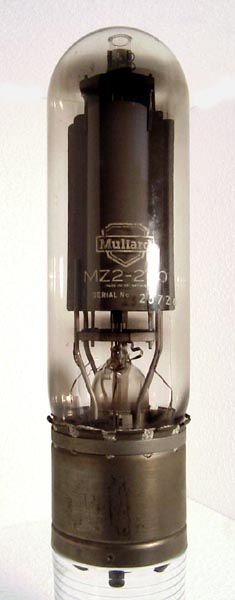
|
The MZ2-200 is at the top end of the capabilities of glass envelope convection cooled power triodes. Above this power rating, cooled anode devices would be used. The valve design dates from the 1930s and is a purpose built audio valve for transmitter service. The MZ2-200 is a Mullard copy of the famous Western Electric type 212E, that was later marketed under the STC label as type 4212E. Also mentioned is a MZ2-250 from the late 1930's but post war the MZ2-200 is listed.The original 212E had a thoriated tungsten filament but the MZ2-200 and 4212E have much lower heater requirements indicating the use of an oxide coated filament. The CV1619 is based on the MZ2-200 and 4212E but the specification calls for the filament to be thoriated tungsten.Uses for the MZ2-200 would be modulators for voice and music transmitters, and also high power public address systems.The filament consumes 30 Watts and is oxide coated.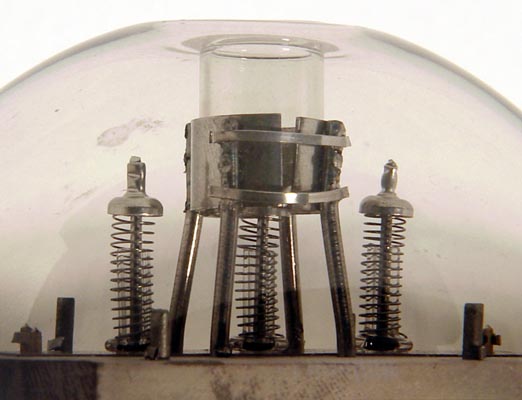
The springs at the top of the envelope apply tension to the filament to avoid it going slack when at working temperature.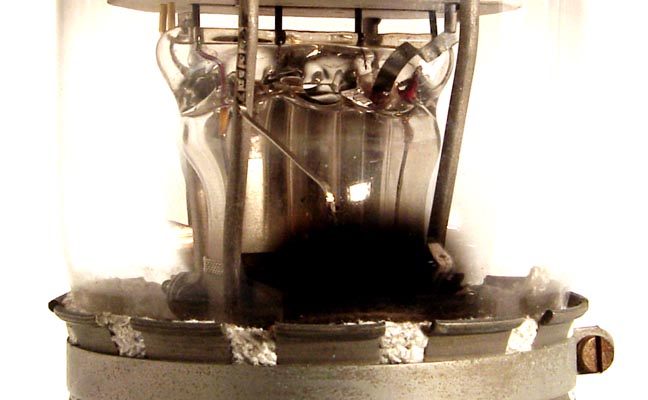
Within the envelope, the anode is fixed around the pinch and held with nuts and bolts, a clear indication of individual hand assembly.The valves were designed to be used in pairs in push pull circuits. At full output the distortion would be 3%.The valve type MZ2-200 is defined by the old Mullard nomenclature. The M denotes a modulator triode, the Z indicates that it is directly heated with an oxide coated filament. The 2 denotes the final anode voltage in kV and finally the 200 gives the anode dissipation in Watts.One of our contributors remembers an amplifier made by Philips that used a pair of these valves. The amplifier provided public address facilities to a large industrial site. Distribution was by 100 Volt line as normal. In this case the line would carry 10 Amps normally and 20 Amps peak.The amplifier was built in two 19 inch style floor standing racks about 6 foot high. The middle rack carried all the valves, mounted on the front of an art-deco styled panel with the MZ2-200s in pride of place. Underneath was a row of octal valves, presumably drivers and pre-amps, and below them were a row of mercury-vapour rectifier diodes. There were six of these, so the presumption is of a three phase mains feed. This would explain how the unit got away with comparatively small (about 12 inch cube) Visconal type paper capacitors for reservoirs - the ripple on full wave rectified 3-phase derived supply is 300Hz and of very low amplitude. All the valves had a couple of guard rails mounted in front but were otherwise completely open. The output valves relied on natural convection and radiation for cooling. The rear of the panels was only protected by comparatively coarse wire mesh which certainly wouldn't have passed the present Health and Safety Executives rules.The other rack contained more than 100 switches used to isolate various parts of the factory from the Light Program (later BBC Radio 2) that was relayed around - some labs were music free zones. Presumably some poor soul had to go into the amplifier room to turn all the switches on when some announcement had to be made to the entire site. An isolated circuit was replaced by one based on an equivalent number little round electric fire elements to maintain a constant load. To complete the impressive set-up, there was a control desk incorporating the radio tuner, record deck and a microphone.When running, the amp was its own disco light show! A vivid purple glow pulsed in the mercury rectifiers in time with the music and on really loud passages the anodes of the MZ2-200s glowed cherry red - good job they are graphite! And of course the grid volts and anode current meters danced around like VU meters.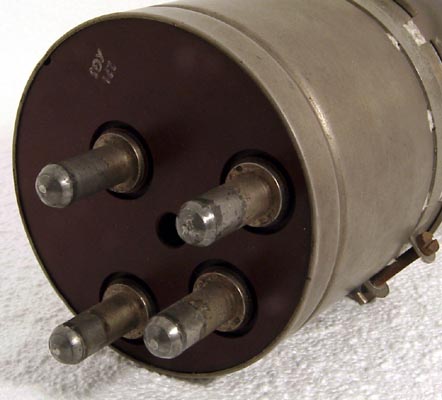
The large four pin bayonet base was Mullard type MVH16. The valves were designed to be operated with the filaments vertical.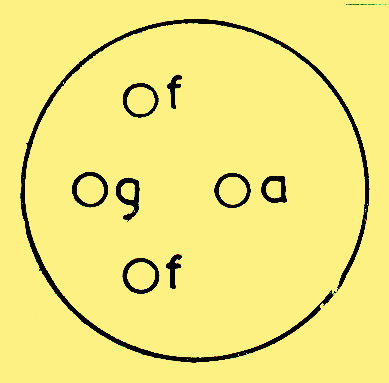
The arrangement of base pins.The wide glass tube envelope is 92 mm in diameter and, excluding the special four base pins, is 320 mm tall.References: Data-sheet, 3002 & 1043. Type MZ2-200 was first introduced in 1938. See also 1938 adverts. |
Pin Connections
| 1 | 2 | 3 | 4 |  f | g1 | f | a |
|
|
Absolute Maximum Operating Conditions¶
| Vh | Ah | Va | mAa | ra | gm | Pdiss | Pout | 
| 14.0 | 2.2 | 2,400 | 400 | 2,085 | 7.2 | 275W | 1,213 |
|
Updated October 27, 2017.
|
|